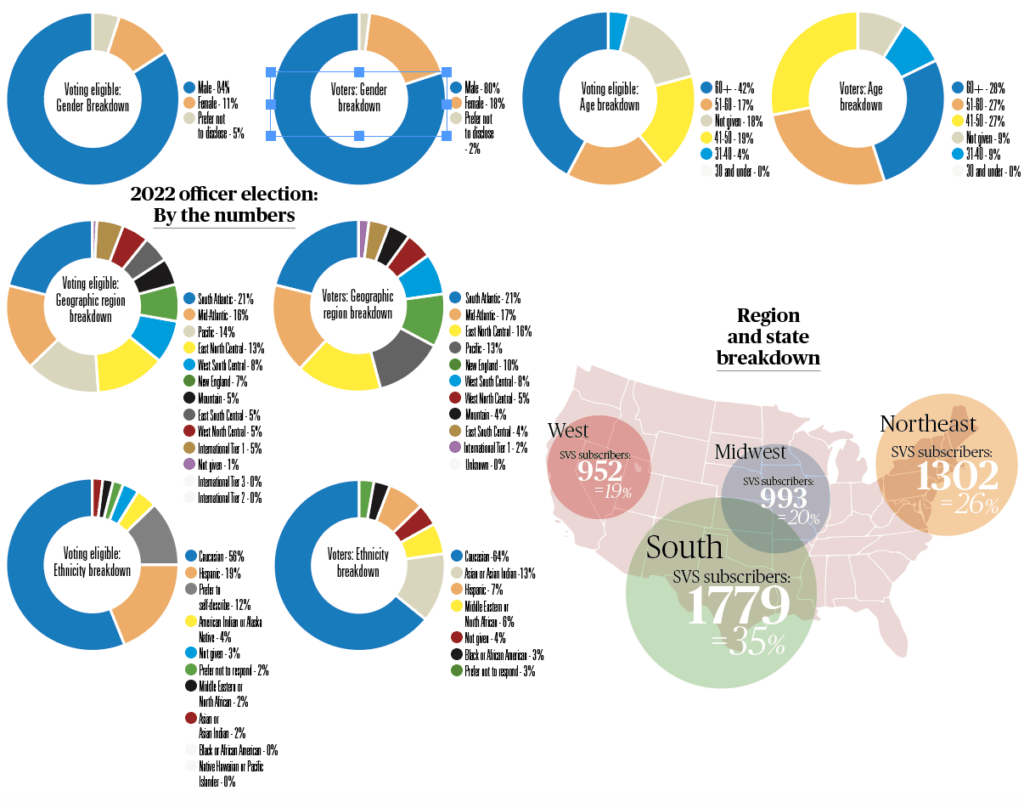
The SVS Executive Board highlights details of the most recent Society for Vascular Surgery (SVS) elections to inform members and further strengthen the process.
In 2020, Society for Vascular Surgery (SVS) leadership proposed, and SVS members resoundingly approved with a 97.7% majority (170-4), a bylaws change affecting officer elections. The change mandated that the SVS Nominating Committee propose two candidates for each open officer position and that voting be open to all qualified SVS members, regardless of their ability to be present at the Annual Business Meeting (ABM) at the Vascular Annual Meeting (VAM).
While the existing bylaws had permitted the committee to advance a slate of multiple candidates, historically this had been uncommon, with the Nominating Committee more typically advancing just one candidate for each open position and the membership present at the ABM endorsing that selection. SVS leadership proposed the bylaws change to ensure that members would always have a choice in the election of their officers and, therefore, empower them to truly influence the direction of the SVS.

The second facet of the bylaws change—opening up the election to all qualified SVS members—required a transition to electronic voting. This change permitted 10 times more SVS members to vote than usually attend the ABM, further empowering the membership to shape and direct the SVS. The results of this change were immediately evident as the inaugural internet election in 2020 engaged 482 voters, substantially more than the 250–300 typically present at the ABM. In 2021 and 2022 the number of members that voted grew to 611 and 602 respectively.
Since internet voting was established in 2020 for that year’s election, the goal has been first to double the number of votes that used to be cast at the in-person ABM at VAM, which averaged 300. This goal has been met with the last two elections engaging 611 and 602 votes, respectively. But aspirations of the SVS Nominating Committee and Executive Board are much higher, with sights set on achieving 1,000 votes amongst eligible voters in the election. Currently, only Active and Senior Members in good standing at the time of the election are eligible to vote.
The Nominating Committee continues to carry out its crucial charge in identifying, vetting, and advancing highly qualified nominees based on commitment and service to the SVS, time availability, track record of leadership success, strategic vision, and a growing awareness and mindfulness of SVS diversity, equity, and inclusion principles.
The 2022 election for SVS officers was held May 23–June 3, during which time 602 members cast their votes for vice president, secretary, and several bylaw referendum changes. The election was well publicized, with SVS members receiving 44 reminders and prompts to vote via various media and social media channels, in addition to 39 reminders and posts regarding the candidate Town Hall, during which candidates and issues were announced and introduced. In all, members were sent more than 70 notices and reminders during the week prior and during the 10-day election period.
The transition to internet voting was initiated to engage every voting eligible member across the country to participate. There are approximately 2,900 eligible voting members in the SVS. Compared to other medical societies that hold internet elections, a 20% voter turnout is considered healthy and above average. The goal of the Nominating Committee and the Executive Board is to achieve at least 1,000 votes, or 33% of eligible voters
In looking at the pool of 602 voters in the 2022 election, the demographics of the voter pool largely parallel the demographics of the overall voter-eligible SVS membership, although there are some differences.
With regard to gender, 80% of those who voted identified as male, 18 % female, and 2% undisclosed. This compares to 84%, 11%, and 5% in the overall voter-eligible membership. The percentage of female voters was slightly larger than the voter-eligible SVS membership, 18% vs. 11%; and the percentage of males slightly lower, 80% vs. 84%.
With regard to age, 28% of voters were 60+ years of age, followed by 27% each for those 51–60 and 41–50, 9% were under 40 years of age. This compares to 42% over 60 in the overall voter-eligible membership, 17% 51–60; 19% 41–50; and 4% 31–40. In general, those who voted were slightly younger than represented in the voter-eligible membership with 36% of the vote from members under age 40, compared to 22% in the voter-eligible membership.
With regard to geographic location, the population of voters was very close in parallel to the voter-eligible SVS membership, with the South Atlantic at 21% for both voters and voter-eligible membership; Mid-Atlantic nearly identical with 17% and 16%, respectively; East North Central slightly over-sampled with 16% and 13%; New England slightly over-sampled with 10% vs. 7%; the Pacific slightly under-sampled with 13% vs. 14%; and West South Central identical with 8%.
Lastly, with regard to ethnicity, it is difficult to make comparisons as the percentages of members who identify as minorities underrepresented in medicine (URiM) are small. Overall, the percentage of voters who represent as non-Caucasian ethnicities appears slightly higher than in the voter-eligible membership, 29% vs. 25%, but this may be due to more non-Caucasian members identifying as a different ethnicity compared to the voter-eligible membership profile.
The transition to open internet elections in the SVS is going into its third full-year. The work of the Nominating Committee is challenging because the SVS is blessed with an abundance of qualified nominees, and it is likely that due to the high quality of candidates, elections will be predictably close, so every vote matters. “It takes your vote to shape the Society you want to see into the future,” noted SVS President Michael Dalsing, MD. The SVS Executive Board and Nominating Committee are currently deliberating further improvements to broaden diversity and choice in candidates, and increase member engagement in the election. If you have comments, email [email protected].












